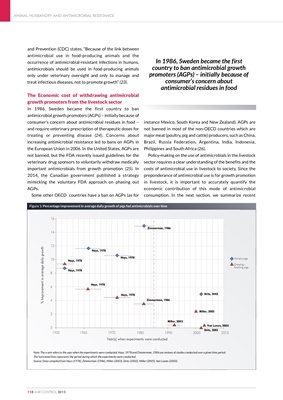
and Prevention (CDC) states, "Because of the link between
antimicrobial use in food-producing animals and the
occurrence of antimicrobial-resistant infections in humans,
antimicrobials should be used in food-producing animals
only under veterinary oversight and only to manage and
treat infectious diseases, not to promote growth" (23).
The Economic cost of withdrawing antimicrobial
growth promoters from the livestock sector
In 1986, Sweden became the first country to ban
antimicrobial growth promoters (AGPs) - initially because of
consumer's concern about antimicrobial residues in food -
and require veterinary prescription of therapeutic doses for
treating or preventing disease (24). Concerns about
increasing antimicrobial resistance led to bans on AGPs in
the European Union in 2006. In the United States, AGPs are
not banned, but the FDA recently issued guidelines for the
veterinary drug sponsors to voluntarily withdraw medically
important antimicrobials from growth promotion (25). In
2014, the Canadian government published a strategy
mimicking the voluntary FDA approach on phasing out
AGPs.
Some other OECD countries have a ban on AGPs (as for
instance Mexico, South Korea and New Zealand). AGPs are
not banned in most of the non-OECD countries which are
major meat (poultry, pig and cattle) producers, such as China,
Brazil, Russia Federation, Argentina, India, Indonesia,
Philippines and South Africa (26).
Policy-making on the use of antimicrobials in the livestock
sector requires a clear understanding of the benefits and the
costs of antimicrobial use in livestock to society. Since the
preponderance of antimicrobial use is for growth promotion
in livestock, it is important to accurately quantify the
economic contribution of this mode of antimicrobial
consumption. In the next section, we summarize recent
ANIMAL HUSBANDRY AND ANTIMICROBIAL RESISTANCE
118 AMR CONTROL 2015
0
2
4
6
8
10
12
14
16
1950 1960 1970 1980 1990 2000 2010
Year(s) when experiments were conducted
% Improvement in average daily growth
Hays, 1978
Hays, 1978
Hays, 1978
Hays, 1978
Zimmerman, 1986
Zimmerman, 1986
Hays, 1978
Hays, 1978
Dritz, 2002
Miller, 2003
Van Lunen, 2003
Miller, 2005
Dritz, 2002
Nursery pigs
Growing -
finishing pigs
Figure 1: Percentage improvement in average daily growth of pigs fed antimicrobials over time
Note: The x-axis refers to the year when the experiments were conducted. Hays, 1978 and Zimmerman, 1986 are reviews of studies conducted over a given time period.
The horizontal lines represents the period during which the experiments were conducted.
Source: Data compiled from Hays (1978), Zimmerman (1986), Miller (2003), Dritz (2002), Miller (2005), Van Lunen (2003).
In 1986, Sweden became the first
country to ban antimicrobial growth
promoters (AGPs) - initially because of
consumer's concern about
antimicrobial residues in food